|
THE TOP 10 RACING GAMES
YOU'VE NEVER HEARD OF
Stuart Campbell is really old, and while this means he can’t remember
what he went to the Post Office for, he can remember loads of old
videogames that you can’t. If you indulge him by listening as he tells
you about some of them now, he promises not to go on about the war and
how it all used to be fields round here.
When it comes to retrogaming, racing
games aren’t traditionally our beloved field’s strongest suit.
Racers really came into their own in the 32-bit era, when the speedy
processors of the Playstation and the Saturn finally made proper 3D
viable, and on first look it doesn’t seem like there was all that
much for retroheads to get excited about before 1994 or so. But in
fact, that’s only true if you have an incredibly superficial
definition of what a racing game is.
Around the turn of the millennium there was a paradigm shift in the
genre (Man! I’ve always wanted to say “paradigm shift in the
genre”!), at which point it became almost impossible to get anyone
to publish any game involving cars which didn’t involve agonising,
painstaking technical driving just to get round a single lap of the
first track, adjusting your individual wheelnuts for 20 minutes
before every race, and having to work for hours and hours to
“unlock” things before the game would even let you have a go on any
of the fun courses. (Thankfully there’s a bit of a backlash going on
again at the moment, with your Burnouts and your Full Autos and your
Ridge Racers back in the picture.)
But racing games weren’t always such stuck-up dullard killjoys. In
the old days, during the war when it all used to be fields round
here, racing games came in a hundred different flavours. RG47 listed
25 of the most popular, but what about all the classics that snuck
under the radar? What about all the games that influenced some of
today’s biggest names, but never get any credit for it because only
three people ever played them? It’s an outrage! If I was you, I’d
DEMAND that someone tells you about at least ten of them RIGHT THIS
MINUTE. Write to your MP if necessary.
----------------------------------------------------------------------------------------------------------
10. AB COP
(Arcade/1990/Sega)
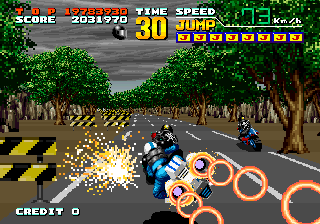
A game as pathologically shallow as AB Cop
never stood a chance of
getting a home release, but fortunately it runs a treat in MAME.
Sega’s distinctively-styled
sprite-scaling coin-ops of the early 1990s – Out Run, After Burner,
Space Harrier, and lesser lights like Galaxy Force and Power Drift –
are endlessly lionised by videogamers, which makes it all the
stranger that AB Cop has had posterity entirely pass it by. At heart
a ripoff of Chase HQ from two years earlier, AB Cop puts you in the
helmet of a law-enforcement officer on an “air bike” (hence AB),
charged with hunting down the scary alien monsters leading a set of
motorcycle gangs. Armed only with a brief but infinitely-recharging
turbo boost and a limited jump ability, you have to ram all the
bikers off their mounts before the time limit runs out, at which
point you get to tackle the giant boss head-on.
But while the formula is as generic as can be, the thing that marks
AB Cop out is the sheer frivolous joy of it. The levels are fast,
hectic and short, the bosses are mostly pretty easy, and the
shit-eating grin your character turns to flash at you at the end of
each stage sums up perfectly the 30 seconds of dumb fun you’ve just
shared and the anticipation of the next 30. It’s kind of like going
round to Burnout 3’s house and meeting his dad, who turns out to be
really funny and much more entertaining to be around than his rather
po-faced wannabe-gangsta offspring. It’s a real shame that it’s
complete rubbish like After Burner that gets remembered from that
halcyon Sega era instead of games like AB Cop, but then on the other
hand you get the pleasant surprise of discovering it now, so
everyone wins in the end. Phew!
----------------------------------------------------------------------------------------------------------
9. CHAMPION DRIVER
(Amiga/1992/Idea)
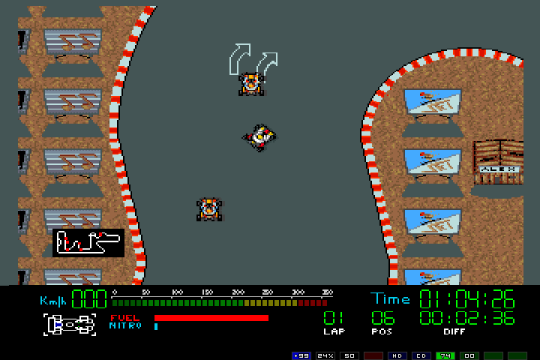
Champion Driver only appeared on the Amiga and
your chances of tracking down an original
disk now are extremely remote, so there’s no escaping the fact that
you’re going to have to
wrestle with WinUAE, the highly-capable but daunting Amiga emulator.
Good luck!
The close-overhead-view scrolling
racer was a popular genre in the 16-bit era, representing a way of
depicting complex tracks and decent numbers of opponents at a
respectable speed. There were many well-known examples on the Amiga,
most of them dreadful (Overdrive, ATR and the wildly over-rated
Supercars and Supercars 2), but by far the best was one of the
earliest, and certainly the least-acclaimed. Champion Driver, from
Spanish developers Idea, is in fact perhaps the best example of this
game type on any format ever. (The magnificent Roadkill was ruled
out on a technicality for having weapons, which isn’t really what
we’re about here.)
It offers 50 tracks across five difficulty settings, from the gentle
Formula Kart all the way up to the blindingly fast F1, and a light
smattering of strategy in the form of upgrade parts, nitro boosts
and pitstops for refuelling. The handling is lovely, varying as you
move up through the formulae and featuring the nicest powerslides
this side of Ridge Racer, and the enemy AI is unusually impressive
for the time (which is to say there is some), with CPU drivers
who’ll weave across the track to block you and get right in your
racing line on corners. There isn’t really much more to be said
about Champion Driver – the recipe is as simple as it gets, but it’s
never been baked as tastily as this before or since.
----------------------------------------------------------------------------------------------------------
8. CISCO HEAT
(Arcade/1990/Jaleco)
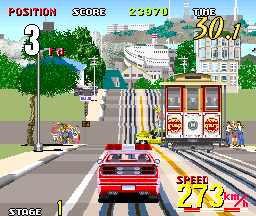
Cisco Heat was ported to most of the 8-bit and
16-bit micros, but none of the home versions bore more than a slight
passing resemblance to the arcade game. The MAME implementation
has a few flaws (mostly with the sound), but it’s very much playable
nevertheless.
I liked this one so much I bought the
company. Well, when I say “company” I mean “arcade cabinet”, when I
say “bought” I mean “won”, and when I say “won” I mean “stole”. But
that’s another story. Cisco Heat starts off with a fantastic
unspoken premise – that the San Francisco Police Department are
apparently bored of fighting crime, and have decided to have a
police-car race through the streets instead. Scene thus set, it’s
time for a lightning tour of the city’s most famous landmarks
(allegedly accurately mapped), in a game that creates a sense of
place that’s rarely been bettered. (Another contender in that
category would have been Konami’s legendary GTi Club, had there been
any way to play it or even get screenshots of it for the feature.)
In fact, not until Crazy Taxi a decade later would a game so
evocatively depict its setting – the same one, as it happened.
The technology of the time wasn’t really up to what Jaleco were
trying to do, but they made an admirable fist of it with what they
had, managing to pull off even 90-degree junctions in a completely
2D plane with some aplomb. The trademark rollercoaster San Francisco
hills are wonderfully rendered, and the city is alive with
incidental detail (fire engines spilling water across the road,
upturned cars, trams and buses and taxis, even the famous fog) that
gives it an incredible vibrancy as you hurtle through it,
frantically honking your horn to move the traffic out of your way.
If you were allowed to drive your real-life car however you wanted
without fear of penalty points, arrest or death, Cisco Heat is what
it would be like.
----------------------------------------------------------------------------------------------------------
7. FIRE TRUCK
(Arcade/1978/Atari)
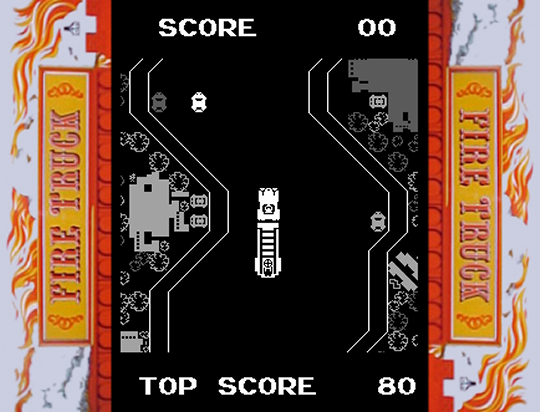
Fire Truck in MAME looks even prettier
when set into the
marquee graphics using the emulator’s “artwork” facility.
For obvious reasons, most of the games
in this feature tend towards the more simplistic end of the racing
spectrum. But the oldest game of all is also the one with the most
sophisticated and challenging handling model of the lot, and one
which wouldn’t be revisited for 25 years (in the shape of Sega’s
2003 semi-classic Eighteen Wheeler). A follow-on from Atari’s
similarly-styled Super Bug of the previous year (also well worth
checking out, incidentally), Fire Truck at once simplifies and
complicates the gameplay, doing away with the constant 4-speed
gearshifting of its predecessor but introducing the complex physics
of trailer-towing.
Driven on by the constant nagging howl of a siren towards a fire
that you never get to reach, and controlling a vehicle with no
brakes and steering like a whale rollerskating on an ice rink, few
games keep the player on a continuous knife-edge of panic like Fire
Truck. Forced to drive far too fast through the leafy,
obstacle-strewn suburbs to beat the tight “extend play” time limit,
with every sudden turn setting your shredded nerves on high alert
for the sickening “CRUNCH!” of inevitable collision, gives the game
a white-knuckle terror at odds with its sedate actual speed, and the
sheer sense of achievement you get if you manage 10 seconds without
a crash makes Fire Truck stupidly addictive.
An obvious predecessor to games like
Thrust (as well as the entire Drift Out genre still popular in
Japan, which in turn led to the likes of Sega Rally), it was the
first driving game to feature drift as a central mechanic, and may
still be the hardest ever produced. If you fancy yourself a skilled
technical driver because you’ve won a few races in Forza 2, stand by
to have your illusions well and truly hosed.
----------------------------------------------------------------------------------------------------------
6. SUZUKI ALSTARE EXTREME RACING
(Dreamcast/1999/Kemco)
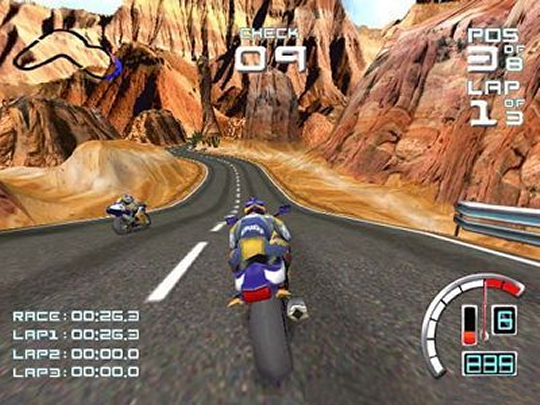
The game was also released on the PC, so one
way or another you should have no trouble finding
a cheap copy somewhere. (In fact, I just checked and the typical
eBay price is about a fiver.)
Well, if Metropolis Street Racer can
make it into the “Best 25 Racing Games You’ve Heard Of” list, then
I’m having this one. (And also, I was going to put the excellent,
unfairly-ignored Top Gear Overdrive on the N64 in here, but it’s
completely impossible to get screenshots of, so it can sod off.)
Besides - it came out last century, almost a decade ago, before MSR
and earlier than many N64 games, and surely that qualifies as
“retro” by now?
Anyway, this glorious racer is a motorbike game that really feels
like a motorbike game, not a car on two wheels. If you try to ride
your various superbikes like they were cars you won’t make it to the
first checkpoint, swerving wildly from side to side and smashing
into everything in sight. But grasp the fact that you’re on two
nimble, responsive wheels and you’re in for some of the most
exhilarating racing of your life – whipping through rock canyons and
up mountain tracks, slaloming under piers on golden beaches, zooming
down winding country roads bathed in sunshine or zig-zagging through
dark docks and gloomy city streets. The pace is breathtaking, the
track design superb, the scenery beautiful, the handling/learning
curve perfect. You may, quite simply, never enjoy a racing game more
than this.
Suzuki Alstare Extreme Racing has a Gamerankings average score of
56%, which just goes to prove - if proof were needed - that most
game reviewers are ABSOLUTE TOOLS.
----------------------------------------------------------------------------------------------------------
5. HOT ROD
(Arcade/1988/Sega)
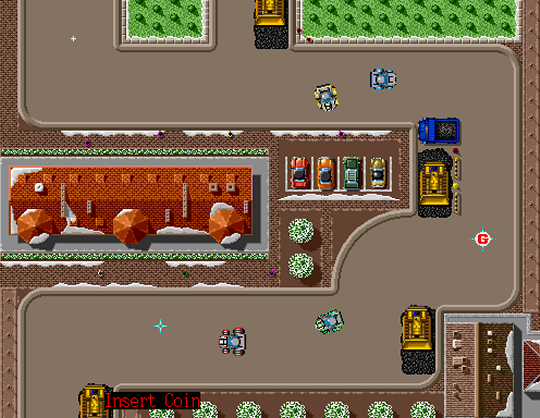
If you want to play a game that’s a lot like
Hot Rod except 1,000 times easier, pick up
the Amiga conversion by Activision, which also looks like a child
drew it with
blunt crayons but is a lot less frustrating for the cack-handed
player.
The clean, cartoony graphics of Sega’s
late-80s System 24 arcade hardware gave a distinctive look to the
company’s next generation of games (After Burner, Out Run, Space
Harrier and the like all ran on System 16), as well as offering the
possibility of a range of styles much wider than variations on
“stuff rushing out of the screen at you at breakneck speed”. Sharing
the trademark rich colours and rounded edges with varied games like
Bonanza Bros, Crack Down and Scramble Spirits came Hot Rod, an
oddly-shaped cocktail-table-type arcade cabinet with three steering
wheels around its edges containing a game that’s the spiritual
predecessor of Micro Machines.
With the same scrolling-catch-up mechanic and similarly cutesy
toy-car-looking visuals, Hot Rod looks similar to other
overhead-view racers but plays very differently. The better you do
the faster your reactions have to be as you get closer to the edge
of the screen, and the game is very unforgiving of mistakes. You
need to be either incredibly precise or cleverly tactical,
recognising situations where you can grab juicy bonuses and crucial
gas refills before you get zipped back onto the screen, and
simultaneously avoid some especially tricky section of track and
steal a march on your rivals. It’s a game that’s all about seeing
what’s on the next level if you play it by yourself (so you’ll need
discipline with the credit button if you don’t want to ruin it), but
multiplayer is obviously where it really shines.
----------------------------------------------------------------------------------------------------------
4. CRAZY CARS 3
(Amiga, ST/1992/Titus)
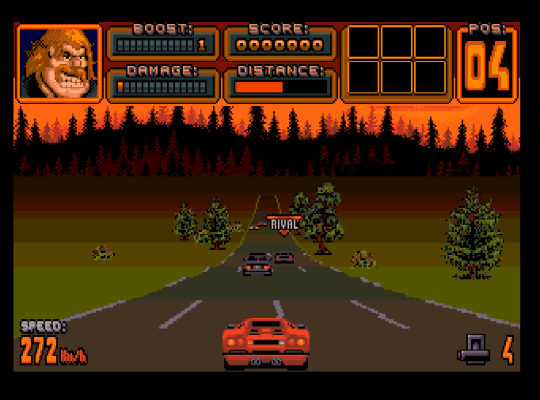
The Lamborghini version of the game was also
brought to the SNES and (less successfully)
the mono Game Boy. The SNES version runs on ZSNES, and while it’s
substantially inferior
in terms of polish, challenge and prettiness, it does save you
buggering about with WinUAE.
For some reason, only coders from
mainland Europe ever really seemed to be able to make racing games
work on the 16-bit computers (with the honourable exception of Her
Majesty’s own Gremlin Graphics, creators of the Lotus series and
also Nigel Mansell’s Grand Prix). We’ve already seen Champion Driver
from Spain, and it was only after some difficult soul-searching that
the splendid Vroom by Ubi Soft of France didn’t make the final cut
for this list. (It was later rejigged into Domark’s official F1
game, bringing it wider recognition.) Loriciels’ early effort Turbo
Cup was the Gran Turismo of its day, but it was yet another French
outfit who came up with the Amiga’s finest racing hour.
Titus’ first two Crazy Cars games had both been spectacularly awful
in every imaginable respect, but by 1992 the developer had hit a
real purple patch of form, kicked off by super platformers The Blues
Brothers and Titus The Fox. There still seemed little chance of them
suddenly getting the hang of racing games after the woefulness of
their previous efforts, but get it right they did, and in stupendous
fashion. Crazy Cars 3 has so much going for it that there’s barely
room to scratch the surface here – it’s a bit like Out Run, Chase HQ
and Metropolis Street Racer on the Dreamcast all rolled into one.
With a dizzying number of courses in a veritable cornucopia of
settings – mountains, cities, farmland, seaside resorts, night
races, rain and snow, you name it - police to avoid, rivals to race
(with side bets for cash to upgrade your car), special challenges on
truck-filled freeways and lots more besides, all wrapped up in
blistering speed with vast draw distances, it was the fastest,
biggest, deepest and prettiest racing game there had ever been.
And yet, partly due to the unfashionability of Euro-software at the
time and partly due to the industry’s relatively primitive
distribution networks, it sold about six copies despite
mostly-gushing reviews, and even when it was rebadged two years
later with a fancy official licence and a split-screen two-player
mode as Lamborghini American Challenge it still didn’t seize the
idiot public’s attention, which is a tragedy on a par with the Great
Plague.
----------------------------------------------------------------------------------------------------------
3. VIRTUA RACING DELUXE
(32X/199x/Sega)
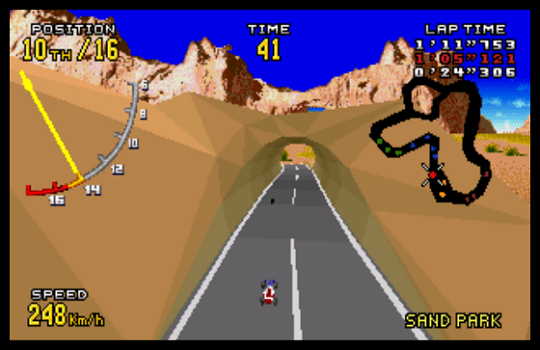
The tremendous multi-Sega emulator Gens does a
grand job of running VR Deluxe.
Now I know what you’re thinking -
”I’ve heard of Virtua Racing, you idiot! Also, what ARE those weird
flappy bits on the heads of chickens for?” But while you’ve
almost certainly heard of and played Virtua Racing (the original
runs pretty nicely in MAME nowadays), the chances that you’ve
experienced its finest incarnation are somewhere between zero and
half of nil. Virtua Racing Deluxe appeared only on the 32X, the
inexplicable mushroom-shaped add-on semi-console that confused the
hell out of everyone during the strange, dark periods in the early
1990s when absolutely everyone at Sega was perpetually blind drunk,
and as a result is one of the most unknown and under-appreciated
racing games of all time. It’s about four billion times better than
the Saturn version the company released a year or two later, better
than the respectable recent PS2 remake, better than the
tiresomely-hyped Scud Race – better, in fact, than 99.23% of all
racing games ever.
In addition to the three superbly-crafted tracks of the coin-op,
Deluxe adds two more equally well-designed ones – Highland, which is
actually a twisting city/mountain course reminiscent of Ridge Racer,
and Sand Park, a fast desert canyon where you expect to be passed at
any moment by the Road Runner with Wile E Coyote in hot pursuit.
There are also two new classes of cars to race in (the slide-happy
Stock and the lightning-quick Prototype), but it’s actually the
restraint in terms of content that makes VR Deluxe so perfect – the
fact is, there is no better two-player racing game to be found on
the planet.
Sit down in front of the horizontal split screen with a buddy for a
five-race series (5, 10, 15 or 20 laps a race) and you’ll be
enjoying the purest competitive videogame racing experience known to
man. The five courses all call for different skills, so the reckless
flat-out speed merchant and the precise, technical driver both get
their chances to shine, and you’ll simply never tire of the
beautifully balanced first-to-three contest. You won’t even notice
the pop-up or the wasp-trapped-in-a-loudhailer sound, because you’ll
be so focused on hitting the racing line on the road in front of
you, on tracks so memorable you could drive them blindfold anyway.
In fact, if there’s a racer anywhere in your soul, your mind will be
in Heaven.
----------------------------------------------------------------------------------------------------------
2. MONACO GP
(Arcade/1979/Sega)
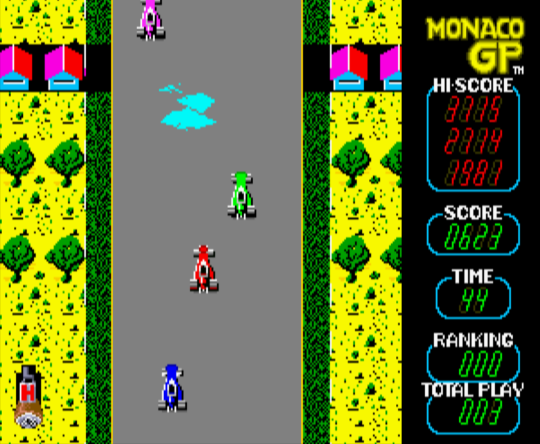
Monaco GP is so old that it actually ran
from solid-state logic gates rather than code on a ROM chip, and
so it can’t be emulated as such. The only accurate home version
is this one for the Saturn, found on the Japan-only compilation
Sega Ages Memorial Selection Volume 2, which runs well
on the Saturn emu SSF if you don’t have an import Saturn. (And,
indeed, still does even if you do.)
Alert viewers will have noticed that
there are basically two types of game in this feature (and, indeed,
in the world of racing games in general). Some racing games are
fundamentally about staying on the road, and some are fundamentally
about avoiding crashing into stuff that’s ON the road. (The most
popular modern examples would be the Gran Turismo and Ridge Racer
series respectively – in Ridge Racer games, while it’s sometimes
possible to spin off the track, walls usually keep you funnelled
down the course and always pointing in roughly the right direction,
whereas in GT it’s all too easy to find yourself sitting motionless
in a gravel pit pointing back the way you just came.) And if you
trace the heritage of the Ridge Racer-type line all the way back to
its roots, the game you arrive at is Sega’s quite literally seminal
Monaco GP. (The ultimate granddaddy of the other type, incidentally,
is Atari’s Sprint 2 from 1976, which oddly pre-dates Sprint 1 by two
years.)
It might seem hard to believe looking at it now, but in its day
Monaco GP was the pinnacle of eye candy. As well as being the
first-ever colour racing game, with its detailed, varied scenery it
was also the first game that people played just to see what was
coming up next. (Videogames until that point mostly took place on a
single static screen.) Through countryside, over ice (yep, another
first – weather effects), into tunnels (with a fantastically
inventive “headlights” effect), across
bridges and more, Monaco
continually urges the player to get better in order to see more. (It
has a unique system whereby you’re initially racing against a
90-second time limit, but when you reach Extended Play you suddenly
have lives instead, with each additional 2000 points granting you
one extra crash, so that a brilliant player can theoretically go on
forever.)
But all of these firsts are just historical footnotes, worthless
unless the game is actually enjoyable to play. Luckily, Monaco GP
delivers that in spades. It’s fast, with super-responsive handling,
and the constant stream of weaving traffic and ever-changing
conditions (sections can last as little as three seconds) mean you
can’t afford to let your concentration slide for a fraction of a
moment. It’s a white-knuckle ride from start to finish, and as much
fun to play today as it was 30 years ago, even if you never saw it
at the time. Monaco GP’s timelessly wonderful gameplay is what
retrogaming is all about.
----------------------------------------------------------------------------------------------------------
1. ROAD FIGHTER
(Arcade/1984/Konami)
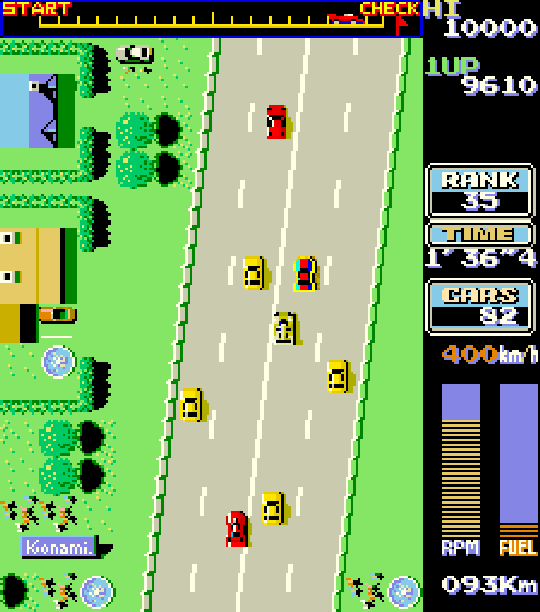
The NES got an almost arcade-perfect port of
Road Fighters, except that in keeping with
Nintendo’s incredibly
cheapskate business model of the time (and now, come to that) you
only got the first four levels. There was also one for the MSX with
some significant gameplay changes. However, the full original can
now be found on the DS as part of the excellent Konami Arcade Hits
collection, where it suits the bite-sized gaming of the handheld
format perfectly.
To the best of your reporter’s
knowledge, Road Fighter is the only arcade racing game ever to have
been controlled with a joystick rather than a steering wheel, but
it’s not that quirky little claim to fame that makes it so special.
Road Fighter is identifiably descended from Monaco GP (even more so
if you’ve seen Sega’s very different home version of Monaco for the
Japan-only SC-1000 console), taking its core values and refining
them into one of the most challenging and addictive racing games in
history.
On first glance at its control panel and tiny graphics, Road Fighter
looks like the most primitive sort of obstacle-dodger imaginable.
But it actually has the most advanced driving model of its era, by
virtue of the fact that it’s the first ever racing game to feature
“realistic” skid-handling, ie forcing you to counter-intuitively
turn INTO the direction of the skid in order to regain control of
your car as it slides across the tarmac after a collision with an
opponent (you only blow up if you hit the side of the road, or a
static or very large obstacle like a lorry). In other words, without
Road Fighter, you’d never have seen Daytona USA.
As with Monaco GP the big draw is seeing what’s coming up next, with
six varied and pretty stages to traverse before your fuel runs out
and lots of hidden bonuses to discover. (Driving without crashing
for an extended period in the first stage, for example, is rewarded
with a fly-past from an F-4 Phantom jet fighter and 3000 points,
while saving yourself from a skid at the last possible second before
smashing into the side of the road can net you 3000 more. I only
discovered the latter while playing RF for this feature - a trifling
24 years after I first encountered the game, it’s still revealing
new secrets.) The road is populated by a wide range of vehicles -
from slow-moving civilians who always go in a straight line and
rainbow cars who can be rammed for points and extra fuel, to
lane-weaving rivals and evil red maniacs who deliberately try to
swerve into you as you pass - but if you’re really quick-thinking
you can identify when you can use their various characteristics to
simply “pinball” your way through a knot of heavy traffic without
having to slow down. (A tactic that lives on today in the Gran
Turismo series, of course.)
Road Fighter is a game where both your mental and physical reflexes
will have to be on top form if you’re to have any chance of reaching
the end. It’s as mercilessly addictive as Sega Rally, and for many
of the same reasons – it’s fast, short and accessible, and its
superficial facade reveals more and more depth the longer you play.
I’ve loved it for a quarter of a century, and if you give it a
chance you will too.
It’s the best racing game you’ve never
heard of!
|

